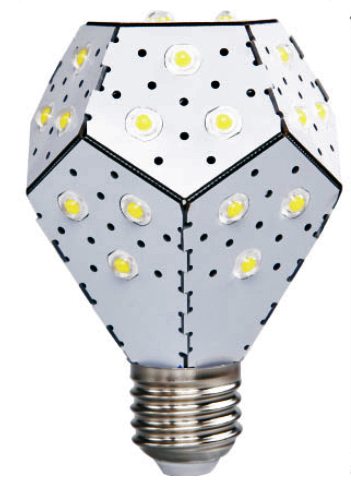
We just bought a condo, and we’ve been buying things we need to get it set up. One of the things we purchased was a bunch of CFL bulbs for three floor lamps and a couple of new bathroom fixtures. We paid $100 for those bulbs, but at least I know I’ll be saving electricity and that the bulbs will have a longer life than incandescent bulbs. My initial outlay would have been much higher if I could have purchased these NanoLeaf bulbs now, but my long-term savings promise to be much higher than I’ll see with the CFLs. These bulbs do away with the glass enclosure and the heat sink current LED bulbs use, because their design allows them to run cooler. The glass and metal have been replaced with a folded up, printed circuit board that has high-quality LEDs arranged so they produce a lighting pattern more like an incandescent bulb than do current LED bulbs.
The designers say that the NanoLeaf may be the most energy-efficient bulb in the world. A true 100W-equivalent NanoLeaf should be able to produce 30,000 hours of light for $50 in electricity. It would take four CFLs and $100 of electricity or 30 incandescent bulbs and $400 in electricity to produce 30,000 hours of light. You may pre-order NanoLeaf bulbs now, with delivery expected in March 2014. (Just a note: the NanoLeaf bulbs started out as NanoLight on Kickstarter. It was fully funded in March 2013, but the bulbs still are available only on pre-order at the NanoLeaf website and on Amazon in the US.) Prices range from $35 for a 75W-equivalent bulb to $100 for a 12W bulb that produces 1800+ lumens.



Gadgeteer Comment Policy - Please read before commenting
Go to the aliexpress for huge assortment of led bulbs. Not all but some of them has a very good quality and cost about 3-10 dollars. Almost all bulbs in my flat are leds from aliexpress.
I replaced almost all my bulbs with Sylvania LED. Within a year, they all failed, Every single one. After going back into lowes with a mile long receipt showing trades, and replacements every 30 days, they refunded the whole batch. I have a few GE’s right now, that SO FAR appear good. I saw this and was very intrigued, I wanted to wait awhile to see how they really stood up. However now that we have a Solar system, our PGE bill went from almost $600/mo in summer to $15/mo. We do however have a $120/mo solar bill, but $120+$15 < $600 so WIN. I'm a little less worried about eaking every single mW out of power.
My concern about LED bulbs is the color of the light. Are these the whit-white light I get from my desk lamp or are these a warmer light suitable for a living room?
Andrew, your solar system charge of $120/month, is that for the “lease” on the panels or the loan repayment?
@Bob Y: I don’t know about THIS light, but there are warm led bulbs now.
@Richard: Actually it’s through Vivant Solar. It’s a power purchase plan. We purchase all power from them at $0.18 kW/hr. We were stuck in Tier 5 due to our use in california, So we were paying PG&E $0.52 kW/hr (I think I might be off a few cents) Ultimately Vivant is making a killing, they got the tax credits, and sell the power back to PG&E, AND get paid by me. But the end result to my pocket book is a huge reduction on my utility cost with zero cost out of my pocket. In 20 years the contract is up, and the panels are abandoned. If you can afford a system outright or even lease, and you plan on keeping the house 20+ years, you will save more money with a Lease or outright purchase. But again I don’t look at it like that. I look at is as me cutting my bill from over $500 a month to less than $150. Made perfect sense for us.
@Andrew: Wow!! Great deal. Thanks for the information.
@Bob Y
According to their website:
COLOR TEMPERATURE
3500K – Warm White
The old style incandescent is about 2700K. I find that to be too warm. I prefer 3000K. I don’t know what 3500K looks like, as the color warmness perception is not linear.
I have a pretty modern lighting system in my house, and all the lights are dimmable. Except for a light in the pantry, I would not consider a light bulb that is not dimmable. So far I have found dimmable LED at The Home Depot that are excellent. The color is constant as you dim them, unlike incandescent. I think the temperature is around 3000K.
meistervu: Thanks so much for this important information….I don’t think I knew anything of this before – the 2700K will help me immensely as I invariably start changing over to LED’s.
My question does these lights have a mercury coating within the bulb to help it make shine brighter? If they do, depends on you municipality or township, they may or may not have facilities to recycle them. In my city the fluorescent and LED lights are ban to go into the regular garbage, due to the mercury content in these lights. Fortunately we have a bio-hazard company on the outskirts of town in order to dispose of them. Unfortunately people don’t the hazards of these lights.
@AnthonyL, I am not aware of any LED bulbs that contain mercury. Even if, as you say, some lights have a “mercury coating within the bulb”, the NanoLeaf lamps do not have a bulb to be coated.